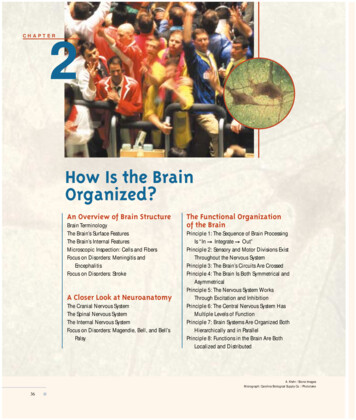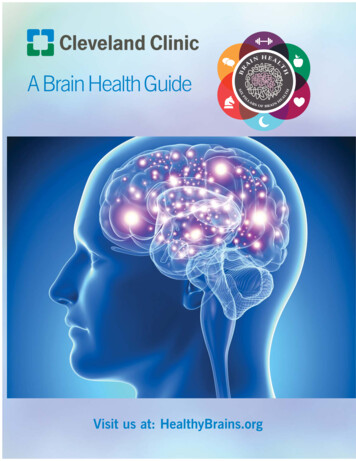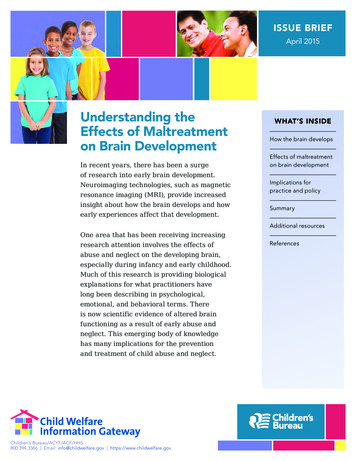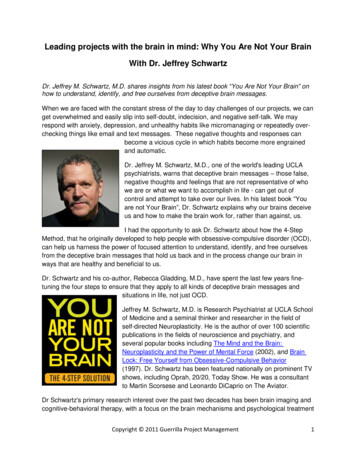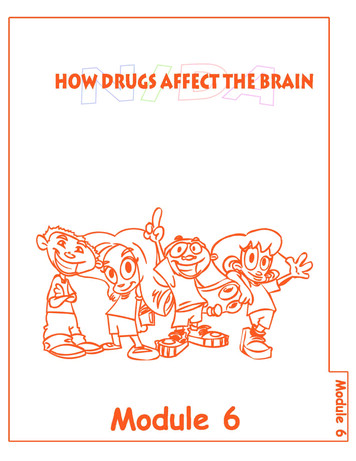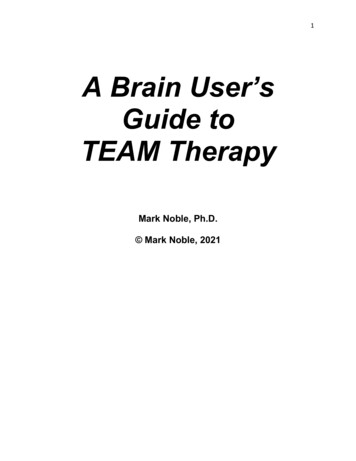
Transcription
1A Brain User’sGuide toTEAM TherapyMark Noble, Ph.D. Mark Noble, 2021
2PrefaceThe success of TEAM therapy (also known as TEAM CBT) in enabling high-speed medicationfree treatment of depression, anxiety and many other emotional challenges has led to a rapidlygrowing interest in this new therapeutic approach. There are now multiple training groupsaround the world that are ongoing and more that are being established. There are also bookclubs that focus on chapter-by-chapter discussions of Feeling Great, the new book by DavidBurns (creator of TEAM therapy).What’s missing is a brief overview of TEAM therapy that enables people to quickly understandwhat it is, how it differs from other therapies, and how to practice this approach. (By brief, Imean something that can be read in a single evening, or less). That’s not a simple challenge.Dr. Burns and his colleagues have recorded over 250 podcasts on TEAM therapy, and FeelingGreat is 500 pages long. There are also 11 other books and countless articles by Dr. Burns, andbooks and articles by multiple other researchers and therapists that are relevant to this topic.Providing an overview of TEAM therapy that helps someone understand it quickly is alreadychallenging – but what makes the challenge even greater is that such a summary would bemore helpful if it could also help explain why TEAM therapy is so powerful. That explanationrequires understanding how this therapy works in terms of brain function. The only way anysuccessful treatment can work is if it’s aligned with the biology of the problem you’re trying to fix.As we’re talking about emotions and habits of thinking, that means the biology of the brain1.Which brings us to this guide, which is written to be useful for the following groups of people: If you’re having emotional problems and want to work with (or are working with) a TEAMtherapist or with Feeling Great then this guide will help you understand what happenswhen you’re using this approach. If you’re like me, then heading towards a particulardestination is a lot more enjoyable if you have some idea of the way to get there. Byunderstanding both the relevant aspects of brain function (written so that you don’t needa college degree to understand them) and the steps in TEAM therapy, you’ll be able tomake this approach even more effective for yourself. Moreover, I think you’ll find thatwhat you’ll learn about your brain will be pretty interesting. If you’re a therapist using TEAM therapy, this guide is written so that you can provide itto your clients as soon as you start working with them (or any time after that). That way,they’ll know what you’re trying to accomplish and why you’re doing what you do. Thatwill make it easier for the two of you to work together. If you’re learning TEAM therapy, or are curious about TEAM therapy, then I hope thisguide will be helpful in understanding what’s special about this approach, why it’s sopowerful, and how to get the most out of it.The guide is in three parts: The first part (12 pages) is an overview of aspects of brain function that I think areneeded to understand how TEAM therapy works, written so that you don’t need a1More information on this topic can also be found in the FeelingGood podcasts #100, 167 and275, and in Chapter 30 of Feeling Great. -mark-noble t-professor-mark-noble-on-team-cbt-and-thebrain )
3 college degree to understand the key ideas. This section distills the most importantinsights derived thus far in the journey to understand the neuroscience of high-speedmedication-free psychotherapyIf you understand how something works, you can make it more effective foryourself. Why do you do this and not do that? Why is it important to do things in acertain way and a certain order? The information in this first section will help you thinkabout such questions in ways that have been helpful to others.The second part (31 pages, including illustrations) is a guide to a typical treatmentsession. This section provides a grounding for exploring TEAM therapy in deeper andbroader ways. It also defines the expectations for a session in TEAM therapy.TEAM therapy was developed through careful scientific analyses of what works andwhat doesn’t, over many years and many thousands of sessions with people with a widerange of needs. Every step in TEAM therapy has a purpose, and no steps can be leftout. But what are those purposes? How do they fit together to enable high-speedrecovery? These are some of the questions examined in this section.Finally, the last section is an attempt to answer some of the questions that come upfrequently in discussions on TEAM therapy.In addition, I’ve written a separate 25-page guide that provides a more detailed analysis of theDaily Mood Log (DML), a critical tool in carrying out TEAM therapy.2 Understanding the DMLand how to use it is critical in conducting and in understanding TEAM therapy. The DML guideis also available with the Brain User’s Guide for your free download. If you’re interested in theguide to the DML, I suggest reading this User’s Guide first. This is because most of theinformation on brain function referred to in the DML is in the User’s Guide.The goal of both of these guides is to make the most fundamental principles of TEAM therapyeasier to learn and to use for your own benefit. Just as for any skill, learning the basic principlesmakes it much easier to learn more advanced techniques. The material in these guides willtransform your ability to learn from working with your therapist or with Feeling Great, listening tolive sessions, or working in training groups. You now will have the background needed tounderstand what’s happening at each stage of the therapeutic journey. You also have a guidethat allows you to easily re-visit any topic, whenever you need to do that.Both of these guides are copyrighted under what’s called a Creative Commons License. Thatbasically means that the only thing you can’t do is copy them and put your name on them. Otherthan that, these guides are intended to be freely available to all. If you’d like to translate one orboth of them into a different language, just let me know. I’d be happy to also change the text onthe illustrations if you send me translated text to use. It’s also okay if you want to come up withnew illustrations.Whether you are working to improve your emotional state, are learning TEAM therapy as atherapist, or are just curious about TEAM therapy, I hope that you find these guides useful. Ifyou have questions (or criticisms), please let me know.With warm wishes to you all,Mark NobleDecember 20212This is also available for download from links at feelinggood.com podcast 275, and is calledExploring the Daily Mood Log.
4Table of ContentsPrefaceAn introduction to TEAM therapy.Why would you care how TEAM therapy works?Approaching TEAM therapy from the perspective of brain functionPart I: What’s going on in your brain?A. Your brain uses emotions to help keep you aliveB. The cells where it happens1. You have a lot of nerve cells but not a lot ways for them to talk to each other2. Brain function requires specificity3. Specificity is possible because nerve cells work in networks4. You can modify your nerve cell networks - which is how learning occurs5. The rules of effective learning are all important in TEAM therapyC. Thinking fast, thinking slow, and the stories that shape our interpretationsD. Is your brain broken? Or is it just doing its job?Part II: The 10 steps of TEAM therapyStep 1: Committing to an action planStep 2: Finding out how you’re doing (Testing)Step 3: Being accepted, telling your story and activating the nerve cell networks you’re goingto modify (Empathy)Step 4: Work on a moment with the Daily Mood Log (DML)Step 5: What are your negative thoughts?Step 6: Addressing resistance by discovering awesome things about you revealed by yournegative emotions and negative thoughtsMIracle Cures and Magic ButtonsPositive reframing: Finding out the good things depression and anxiety reveal about youPositive reframing gives you the information you need to melt away resistanceStep 7: Are your negative thoughts accurate?Step 8: The Methods of TEAM enhance rapid progress, personalize your therapy, integrateall the information you’ve learned thus far, and help prevent relapsesStep 9: Relapse trainingStep 10: Evaluation: how did the session go?Was it magic?Part III: Additional information on twelve frequently asked questions1. Can I skip over any of the parts of TEAM therapy?2. Are there differences between working on depression and anxiety?3. Can TEAM therapy be used for other problems, like relationships, addictions andunhealthy habits?4. Does TEAM therapy work for everybody?5. Do I have to do homework?6. What kind of homework works best?7. How much homework do I need to do?8. Does TEAM therapy work if I use Feeling Great without a therapist?9. Is brain function as simple as it’s described in this guide?10. What about medications?11. Does the success of TEAM therapy mean that depression and anxiety are “all in yourhead?”12. Are there any publications on analysis of TEAM therapy treatments in the scientificliterature?Additional resourcesAcknowledgementsAbout the 46485050505152535555565757596364646465
5An introduction to TEAM therapy.Welcome to the TEAM team. TEAM stands for Testing, Empathy, Addressing resistance andMethods.TEAM therapy is a new approach to treating depression, anxiety, OCD, PTSD and many otheremotional and psychological (including, e.g., problems, habits and addictions). This approachbrings together the most powerful tools from many different types of psychotherapy into a singlediscipline. It also adds new techniques that are unique to TEAM therapy.TEAM therapy is built to be useful for everyone dealing with emotional challenges. We all haveunique lives and unique brains, and what works best for someone else might not be the bestapproach for you. One of the strengths of TEAM therapy is that it includes many powerful toolsthat help your therapist respond to your personal needs, in the most effective ways for you.The reason your therapist became an expert in TEAM therapy is because this approach is oftenmore effective than other treatments for depression, anxiety and many other problems. Even ifyears of other treatments have not helped you, the TEAM approach can enable the emotionalrecovery that you seek.You can listen to examples of such successes yourself, as live treatment sessions found at thelinks to www.feelinggood.com provided at the end of this guide. You may find the examplespuzzling, however, because the live sessions sound like straightforward conversations. Yet,these seemingly simple conversations cause the rapid recovery that is one of the goals ofTEAM therapy. How can this be?When you listen to live sessions, the effectiveness of TEAM therapy can be so puzzling that itsounds like magic. Perhaps that’s because, as the writer Arthur C. Clarke once wrote, “Anysufficiently advanced technology is indistinguishable from magic.” Although there’s noelectronic, biological or chemical technology in TEAM therapy, it’s an advanced technology ofthe mind.This guide describes what you can expect when you’re working with a TEAM therapist and alsoprovides some possible explanations for what’s happening at each step. With this information,you’ll be able to understand what happens at every step of your own therapeutic journey. You’llalso be able to understand every step in the live sessions available at www.feelinggood.com .This guide is designed to be helpful for multiple groups of people: You may be new to the world of TEAM therapy, and puzzled why it’s so different fromother treatments. The User’s Guide will help you understand how TEAM therapy differsand what the purpose is of features unique to this approach. If you’re working with a therapist, or working on your own by doing the exercises in Dr.David Burns newest book (called Feeling Great), then knowing the purpose of each stepwill help you work more effectively towards recovery. Working with Feeling Great (orDr. Burns’ other books) can offer a powerful approach to improving your emotional life.This is even true for people who don’t have the option of working with a good therapist.The techniques you’ll need already are straightforward – and will hopefully be even morestraightforward with the help of this guide. If you’re a therapist who’s studying TEAM therapy, this guide will hopefully make iteasier to understand how the pieces of this approach fit together, The guide also willhelp you understand why it’s important to do things in certain ways. If you’re a therapist wondering if learning TEAM therapy is worth your interest, I hope theinformation in here will make you curious about learning more.
6Perhaps you think the rapid recoveries that can be achieved with TEAM therapy are impossiblebecause “that’s not how the brain works.” The problem with such a belief is that such rapidrecoveries are being seen by therapists around the world who are using the TEAM approach.Perhaps it’s worth considering a different perspective on brain function, such as that provided inthis User’s Guide.One of the most wonderful discoveries about our brains is that changing unpleasant emotions iseasier than it feels when we’re in the midst of those emotions. This discovery is the basis forsome of the most effective therapies for emotional distress. Learning how to treat such distresscan be one of the most liberating experiences that you can have.Finally, I want to be clear that the use of this guide is not meant to be a replacement for seeinga therapist if you need one. If you’re in emotional trouble, then let someone know.*****Why would you care how TEAM therapy works?It’s easier to work with your mind if you know how your mind works.There are two kinds of treatments for health problems: For some therapies, your active participation is needed to get better. Psychotherapyand physical therapy are good examples of treatments like this. For other therapies, like taking an antibiotic for a bacterial infection, you don’t have to domuch. Just take the pill, and let it do its job.If a therapy requires your participation, you can make it even more effective if you understandwhat you’re trying to accomplish. It’s true that TEAM therapy will work for you whether or notyou understand how it works. If you know what you’re doing at each step, however, you canmake TEAM therapy work even better.Thus, there are several reasons why you might care how TEAM therapy works. For example: TEAM therapy is different from other therapies. Understanding how TEAM therapy workswill help you see why those differences make the TEAM approach more successful. Understanding how TEAM therapy works will help you understand why this therapy canenable rapid recovery from depression and anxiety, even if years of working with otherapproaches have not helped. Every step in TEAM CBT is there because it’s important in enabling rapid recovery. Byunderstanding the purpose of each step, you’ll be able to make each one even morepowerful. Understanding how TEAM therapy works also will help you be more flexible in the wayyou approach therapy. As an analogy, let’s say that you’re trying to get to a particulardestination and you know about all the possible roads and paths that you can use. Ifyou have that knowledge, then you can still figure out how to get where you want to goeven if one of the roads is blocked. Finally, understanding how TEAM therapy works will make it more enjoyable and moreinteresting.With TEAM therapy, you’ll learn the skills you need to restore joy in your life.By understanding how TEAM therapy works, you’ll also be able to make those skills even morepowerful.
7Approaching TEAM therapy from the perspective of brain functionAll the benefits of TEAM therapy are possible because of the way this approach aligns with thebasic functions of your brain, the most remarkable part of your body. The brain is where allyour thoughts and feelings occur. It is the only part of your body that can decide to change itself– such as the change you’re seeking when you decide to work with a therapist. It’s also the onlypart of your body that can then create an action plan to do this, and can make that action planhappen. No other part of your body can do the wonderful things that your brain can do.For any therapy to work, it has to be aligned with the biology of what you’re trying to fix.Antibiotics treat bacterial infections because they kill bacteria. But antibiotics don’t work for abroken leg. And putting a cast on your leg won’t treat a bacterial infection. The biology of thetherapy has to be aligned with the biology of the problem.The most effective approaches for restoring your emotional balance will be the ones that aremost aligned with the biology of emotions.That biology is the biology of your brain.Part I: What’s going on in your brain?In order for TEAM therapy (and CBT in general) to be able to treat the wide range of emotionalmaladies for which they’re used, these approaches must work on principles of brain function sofundamental that they apply to many different situations. Moreover, there do not appear to beany cultural limitations in the utility of the techniques of CBT, so it’s important to think in terms ofbrain functions that transcend gender, race, culture or anything else that varies in differentpopulations.Several critical brain functions help make it easier to understand depression and anxiety, andalso help explain how TEAM therapy works and why it’s so effective.A. Your brain uses emotions to help keep you aliveWhere do your emotions come from? Why do you have the emotions that you do? Knowinghow your emotions are generated can help you when they’re interfering with living a joyful life.To carry out its most important function, which is helping keep you alive, your brain interpretsthe world, predicts what’s going to happen and motivates you to act in a way that matches theseinterpretations and predictions. Those motivations are your emotions.The five steps your brain goes through when it interprets information, makes predictions andgenerates emotions are:Step 1. The brain receives information from inside the body and from the outside world.Step 2. It interprets this information to make sense of what’s happening and to predict what’sgoing to happen next (and what you need to do). Making predictions is one of the mostimportant brain functions. Interpreting information and making predictions occurs quickly andtakes place almost entirely at an unconscious level we don’t even notice.Step 3. The brain next creates emotions as motivations that push you to respond so what youdo is aligned with your interpretations and predictions. This happens quickly and without
8your conscious awareness. Emotions are not a conclusion you reach, like when you solve amathematics problem. Instead, they are rapid and unconscious reactions to yourinterpretations and predictions. Whatever emotions you’re experiencing, the key tounderstanding them is to identify the interpretations that cause them.Emotions come in two basic types, and can motivate you to move towards something oraway from something: For example, your interpretations might predict that something will be enjoyable. If so,they’ll cause positive emotions, like pleasure, joy, enthusiasm, calm, curiosity,friendship, sexual attraction, or the feeling of being safe. When you have a positiveemotion, it’s natural to want to experience more of whatever causes that emotion and3to feel happy if you can do that.interpretationsalso mightpredictthenthat yoursomethingis goingbe unpleasant.If so,Step 5. If Yourthe originalinterpretationwas wrong,brain mayhavetogeneratedthe ame,guilt,feelinghelplessoremotions. If so, they also need to change. (Please remember this idea! It’s the key thator aloneor abandoned.When you have a negative emotion, it’s natural tounlockshopelesshow TEAMtherapyworks.)want to experience less of what causes that emotion and to feel stressed and unhappyif you can’t do that.In other words, emotions are a powerful way the brain tries to match your actions with yourinterpretations. Emotions are immediate, emotions are generated without any consciousthinking, and emotions are powerful! Emotions are powerful because their job is to motivateyou to carry out the actions your brain believes – correctly or incorrectly – will increase thelikelihood of survival.
9Step 4. It’s possible the first interpretations and predictions you make are wrong, so your brainalso needs to do some quality control. In this step, your brain re-analyzes information in casethe interpretations and predictions need to change. If one interpretation is more correct thananother one, your brain usually will choose the one that’s more accurate. After all, you’remore likely to survive if your predictions are based on correct interpretations than incorrectones.Step 5. If the original interpretations and predictions are wrong, then your brain also may havegenerated the wrong emotions. If so, your brain will automatically generate differentemotions to match your new interpretations and predictions.Steps 4 and 5 are the keys to understanding how TEAM therapy works. Working with yourtherapist, or with Feeling Great, you’ll learn powerful techniques for carrying out the qualitycontrol (Step 4) that’s needed to experience happier emotions. Once you carry out Step 4, yourbrain will automatically change your emotions (Step 5) because that is how the brain works.Emotions are the way your brain tries to match your actions withyour interpretations and predictions. Emotions are immediate,emotions are generated without any conscious thinking, andemotions are powerful! Emotions are powerful because their job isto motivate you to carry out the actions your brain believes –correctly or incorrectly – will increase the likelihood of survival.The discovery that emotions come from our interpretations andpredictions is one of the most important discoveries about the brainthat has ever been made. In TEAM therapy, you’ll learn many waysto use this discovery to change the way you feel.B. The cells where it happensEverything that you think and feel is based on the activity of cells in your brain called nerve cells(or neurons). Every memory you have, everything you imagine, every interpretation of yourexperiences, every prediction you make and every emotion you feel all exist because of yournerve cells.With TEAM therapy, you’re going to learn how to modify specific nerve cells in your own brain.You’re going to learn how to conduct your own personal micro-neurosurgery, with a specificitythat no neurosurgeon in the world can match.Understanding how nerve cells work will: Make it easier for you to change them in ways that will make you happier; Help you understand why some of the unique features of TEAM therapy help make thisapproach so powerful; Help you understand why TEAM therapy also is more effective than using medications.Five ideas are critical in understanding how nerve cells work, and how TEAM therapy works.1. You have a lot of nerve cells but not a lot of ways for them to talk to each otherIt takes a lot of nerve cells to store and process all the experiences that help make you who youare, so many that your brain contains around 100 billion of these cells. As a comparison, it’sthought that about 107 billion humans have ever lived in the entire history of the world. So, you
10have almost as many nerve cells in your brain as there are people that have ever lived on thisplanet! And your brain is even more complex than that, because each nerve cell makesconnections with hundreds, or thousands, of other nerve cells. That means there are trillions ofinteractions that occur between the nerve cells tucked away in each of our heads.Nerve cells communicate with each other by releasing small amounts of specific chemicals.These chemicals are called neurotransmitters. This communication mostly occurs betweenspecific nerve cells, but some of the chemicals released can affect larger numbers of cells.There’s a problem with neurotransmitters that’s critical in understanding some of the differencesbetween TEAM therapy and the use of medications – and also helps explain whyantidepressants and anti-anxiety drugs can cause so many different side effects.The problem is this: Although there are around 100 billion nerve cells, there are only around100-200 neurotransmitters. That means that there are millions and millions and millions of nervecells in your brain that all use the same neurotransmitters to communicate with each other. Inaddition, there are other nerve cells in different parts of your body (such as in your gut and yourheart) that also use the same neurotransmitters.Some neurotransmitters are affected by anti-depressants and anti-anxiety medications, but adrug that changes a neurotransmitter changes it all over the body. Every cell that uses thatneurotransmitter, anywhere in the body, is affected. It doesn’t matter what part of your brain thatcell is in, or even if it’s not in your brain at all.One way to think about why this is a problem is to consider your computer: Everything you do on your computer uses electricity, which works like aneurotransmitter. The electricity allows each tiny wire to communicate with other tinylittle wires in your computer. The specificity that occurs is because of how the parts of your computer are connectedto each other.TEAM therapy is like using your computer to do something specific.In contrast, antidepressants and anti-anxiety drugs are like changing the electricity in all thecircuits in your whole computer at the same time. If you change the electricity in your wholecomputer, you change it for all those tiny little wires, with no specificity.The ability to work with specific nerve cells in your brain is critical both in understanding whyTEAM therapy is so powerful and why it’s very different than using medications.2. Brain function requires specificity.How does your brain solve the problem of working with 100 billion nerve cells in an organizedway? It’s hard enough to figure out what’s going on when you’re in a group of 10 people andthey’re all talking and acting at the same time. Yet your brain is able to work with a much morecomplex challenge.The brain doesn’t always work perfectly, to be sure. Still, considering how many nerve cellsthere are, and everything the brain has to do, it generally does a pretty good job of doing whatit’s supposed to do.
11One of the reasons your brain can do its jobs correctly is because nerve cell activation is veryspecific. You can usually find the nerve cells you need whenever you need them.Imagine how difficult your life would be if every time you needed to do something, you had to gosorting through all your different nerve cells to find the ones you need. It’s hard enough to workefficiently if you have to sort through 20 different things on your desk every time you start a newtask. If you had to sort through billions of nerve cells every time you needed to do something,you’d never get anything done.3. Specificity is possible because nerve cells work in networks:How does specificity occur, and how can you use that specificity to transform your emotionallife?One of the reasons that your brain is able to find the right cells when it needs them is becausenerve cells are organized into functional units called networks. Some networks represent asingle simple fact encoded in a small number of nerve cells that may even be located in just onebrain region. Larger networks connect multiple memories and thoughts together with eachother.Understanding a little bit about nerve cell networks will help you understand how TEAM therapyworks. These networks are also critical in understanding how rapid change is even possible,why particular techniques are used at particular times and in particular ways and how to makethem more powerful.Three ideas about nerve cell networks are particularly important in understanding TEAMtherapy: Our memories, our interpretations, our predictions and our emotions all depend on theactivity of specific nerve cell networks. It seems that each nerve cell network can be used whenever the information itrepresents is needed. Learning occurs by modifying nerve cell networks.The reason the same nerve cell networks are used over and over is that even though the brainhas lots of cells and networks, there’s not enough of them to use a different one for everymoment and thought and feeling in your life. For example, you don’t create a new nerve cellnetwork every time you need to solve a math problem where you need to know that 2 2 4.When you first learned that fact, you created a new network. Once that network was created, it’sa much more efficient use of nerve cells to activate that same network whenever you need thefact that 2 2 4.Let’s consider an example of how nerve cell networks are critical in understanding whereemotions come from and why TEAM therapy is effective.Let’s say someone did something awful to you in the past, and caused terrible memories andemotions. All of your memories about that event are contained in nerve cell networks. Eventhough the memories can cause powerful emotions, the memories are not the event. Thememories are groups of nerve cells.The nerve cell networks that represent your memories of an awful event can be activated ifyou’re reminded of the event – and this is how emotional triggers work. Those networks might
12be activated (triggered) by a picture of the person who hurt you, or by a sound, or a smell oreven a word that reminds you of what happened.When
clubs that focus on chapter-by-chapter discussions of Feeling Great, the new book by David Burns (creator of TEAM therapy). . is also available with the Brain User’s Guide for your free download. If you’re interested in the guide to the DML, . Finding out the good




